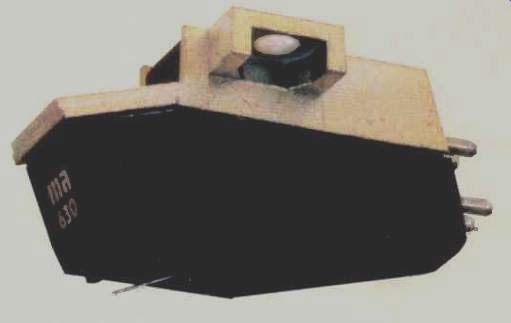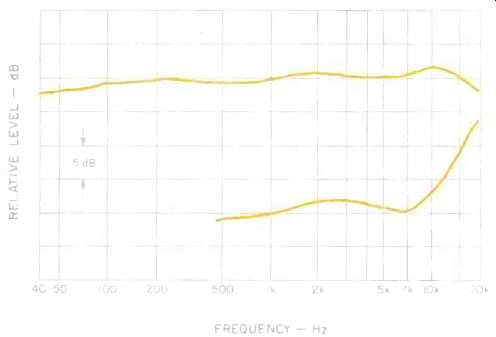
Manufacturer's Specifications
Type: Electret.
Stylus: Micro Point II diamond.
Frequency Response: 5 Hz to 20 kHz, ± 1.0 dB (measured with CBS Labs STR-170 test record and supplied with individual calibration curves).
Separation: 30 dB at 1 kHz, 25 dB at 10 kHz.
Recommended Tracking Force: 0.7 to 1.4 grams.
Output: 3.5 mV. Output Rise-Time: 4.5 µS.
Cartridge Mass: Variable, 2.5 to 4.0 grams.
Dynamic Compliance: 40 x 10^-6 cm/dyne.
Price: $265 00
Company Address: 99 Castleton St., Pleasantville, N.Y. 10570.
Micro-Acoustics' Model 630 is next to their top-of-the-line model and one of the few cartridges on the market that does not use a changing magnetic field as a transducer. As in their earlier models, Micro-Acoustics uses a pair of electrets, permanently polarized dielectric devices. The basic principle was invented by a Japanese scientist, Eguchi, in 1925. He allowed melted wax mixtures to harden in strong electric fields and found that the resulting wax cakes carried a dielectric charge which remained relatively undiminished over a period of years. About 1960, scientists at Western Electric improved the electret so that it would hold its charge indefinitely, and this was the basis for the electret microphone.
The stylus Micro-Acoustics uses is dubbed the Micro Point II, and they say it is an analogue of the Micro Point recording stylus which they supply to the recording industry. According to the firm's literature, the stylus is precision lapped and laser-aligned. It is attached to a 0.01-inch diameter cylindrical cantilever made of beryllium. My first inspection of the cartridge did not reveal the platinum iridium damper their literature mentioned being attached near the back of the cantilever; a phone call to the company enabled me to identify the damper, which is just 0.015 inch in diameter. It is located between the two cylindrical elastomers, near the center of Fig. 1. The resolver assembly is the pyramidal-shaped device which rests on two elastomeric bearings. The two buttons at the upper corners press against two tiny elastomeric pads which rest directly on the electrets. The stylus cantilever can be seen protruding from the apex of the resolver through a hole in the case.
The output of the electrets is connected internally to a resistor-capacitor network IC which converts the linear amplitude response of the electrets to the velocity-responsive output required by phonograph preamps. This circuit makes the output insensitive to variations in preamp input capacitance and resistance, and the outputs of the circuits are connected to the output pins with 24-karat gold wires.
The cartridge shell is made of low-mass carbon fiber. The cartridge comes in a fairly standard case with an assortment of spacers, small weights, nuts, bolts, washers, and a stylus brush. Three half-gram Vari-Balance weights come located under the hinged lid of the cartridge body, so the tonearm's counterweight can be properly adjusted for this lightweight cartridge.

Fig. 1--Close-up view of the Model 630 mechanism, taken from above.
Measurements
The Micro-Acoustics 630 cartridge was mounted in the headshell of a Pioneer PL200 turntable, an older unit with good basic design. As a note to mounting this cartridge, I found that the 630 could not be mounted with the stylus guard in place. I therefore recommend that the complete stylus assembly be removed prior to installation of the cartridge in the headshell, so as not to damage the cantilever.
To reduce mass, Micro-Acoustics uses a removable stylus guard, rather than a hinged guard; there is, then, less protection when the guard is not in position, as required during mounting.
As is the practice of this magazine's phono cartridge reviewers, measurements are made on both channels, but only the left is reported unless there is significant variation.
During the test period, temperature was 70° F, ±2° and the relative humidity was 60%, ± 10%. The following test records were used in making the reported measurements: CBS STR-100 and STR-112; JVC TRS-1007; Deutsches HiFi No. 2, and Shure Brothers TTR-103, TTR-110, TTR-115, and TTR-117. The tracking force determined as optimum and used for all subsequent tests was 1.0 gram with an anti skating force of 1.25 grams. The load resistance was 47 kilohms, and load capacitance was 200 pF. Cartridge weight was 2.7 grams, while tonearm/cartridge resonance in the Pioneer PL200 was at 10 Hz with a rise of 8 dB. As shown in Fig. 2, the frequency response was within ±2 dB from 40 Hz to 20 kHz, as measured with the CBS STR-100. Channel separation measured 20 dB at 1 kHz and dropped to 5 dB at 20 kHz. Static vertical compliance measured 38.4 x 10^-6 cm/dyne, while dynamic vertical compliance was 21.5 x 10^-6 cm/dyne. The lateral compliance was 64.6 x 10^-6 cm/dyne. With a vertical tracking force of 1 gram, the vertical tracking angle was found to be 15°. Output was 3.4 and 3.54 mV (0.96 and 1 mV/cm/S) for the right and left channels, respectively, and balance between channels was within 0.35 dB.

Fig. 2--Frequency response and separation.

Fig. 3--Response to a 1-kHz square wave from CBS STR-112.
The output impedance is a pure resistance of 5.15 kilohms, and the square-wave response was unaffected until a total capacitance of 1,000 pF was placed across the output terminals. Changing the resistive load on the cartridge from the standard 47 kilohms affected only the output amplitude and not the wave shape (as observed on a 'scope). Figure 3 shows the response to a 1-kHz square wave using the CBS STR-112 test record. The rise-time was found to be 13 µS. Micro-Acoustics rates the rise-time of the 630's output as 4.5 µS, which is lower than most high-quality moving-magnet cartridges but not as fast as some moving coil cartridges. Since I was puzzled over the discrepancy, I telephoned Norman Dieter, Chief Engineer of the 630 project, who told me that the STR-112 test record has a built-in rise-time of 8 µS, so the 13 µS I found was not unreasonable. As Fig. 3 shows, this cartridge is very well damped, showing approximately a half cycle of moderate overshoot followed by ultrasonic oscillations at a frequency of approximately 37 kHz. As has been pointed out by Messrs. Pisha and Long in these pages, these oscillations are on the test record and apparently the result of a ringing of the cutter head assembly.
Using the 3.54-cm/S, 45°, 1-kHz signal from the CBS STR100, the total harmonic distortion was 0.3%. IM distortion, using CBS STR-112, with a 4-to-1 mix, was as follows: +9 dB lateral, 400/4000 Hz, left-2.0%, right-2.1%; +6 dB vertical, 400/4000 Hz, left -1.2%, right -1.2%. Deutsches HiFi No. 2 300-Hz test band was tracked cleanly to 90 microns (0.009 cm) lateral at 16.9 cm/S at +9.9 dB and to 50 microns (0.005 cm) vertical at 9.4 cm/S at +4.8 dB. No mistracking was evident in either the output of the left or right channel when tracking the highest (+ 18 dB) 300-Hz lateral band of the CBS STR-112. The + 18 dB band approximates the maximum excursion found on recorded music material. An X/Y plot revealed good linearity and phasing between the two channels.
I also checked output and crosstalk at 16 kHz by using the CBS STR-100's band 3 on side two. Separation between channels was about 16 dB, which is in good agreement with the value obtained from measurements on the stripchart recorder.
The Shure Obstacle Course Era V test disc was tracked up to + 11.1 dB (re: 5 cm/S) which corresponds to a peak velocity of 40 cm/S. There was slight distortion of the 'scope display of the 17-kHz component, though this was not audible. The cartridge was also able to negotiate all the musical tracks of this record up to level 5 of the harp and flute test, where a slight mistracking was heard. Using Shure's TTR103, there was some mistracking evident on side one, band 8, which is composed of 1 and 1.5 kHz mixed at equal levels and recorded at 40 cm/S, peak velocity.
Use and Listening Tests
The Model 630 was used to audition several digitally mastered and direct-disc recordings in conjunction with a Pioneer PL200 turntable. The following discs were among those used in the listening tests and are to be recommended: The King James Version, Harry James and his Big Band (Sheffield Lab 21/22); Beethoven: Symphony No. 6 "Pastorale," The Y Chamber Symphony of New York, G. Schwarz, cond. (Delos D/DMS 3017); Mozart: Symphonies Nos. 40 and 41, Los Angeles Chamber Orchestra, G. Schwarz, cond. (Delos DMS 3012); Dvorák: Serenade in E, Op. 22, Los Angeles Chamber Orchestra, G. Schwarz, cond. (Delos DMS 3011) and Tchaikovsky's Symphony No. 6 in B Minor, Op. 74 "Pathétique" (Mobile Fidelity MFSL 1-512). Two other records used in the listening tests and of special noteworthiness are the Hitachi release, HCR-7301SC, of the Vienna Chamber Ensemble playing Mozart's Divertimento No. 17 in D Major, K. 334, and Rudolf Serkin playing Beethoven's Piano Concerto No. 4 in G Major, Op. 58, with Seiji Ozawa conducting the Boston Symphony Orchestra (Telarc DG-10064). As one would expect from the measurements, the cartridge performed very well in the listening tests. It was particularly good in reproducing sharp percussion sounds such as cymbals and snare drums. Individual vocals, both male and female, were faithfully reproduced with no sense of objectionable unnaturalness in either. Stereo imaging was quite good, with instruments firmly placed, and front-to-back imaging was also very good. Bass was solid and tight, with reproduction going as low as the rest of the reproducing chain allowed. I was particularly impressed with the sonic detail, clarity, and the transparency of reproduction of the strings on the Hitachi recording of the Vienna Chamber Ensemble. In addition, superb reproduction of piano was evidenced by the Micro-Acoustics cartridge on the Telarc recording of Beethoven's Piano Concerto No. 4.
To sum up, then, the Micro-Acoustics 630 should be a strong contender among cartridges in the $200 price range.
-George Shellenberger
(Audio magazine, Mar. 1984)
Also see:
Micro-Acoustics QDC-Ie Phono Cartridge (Jan. 1976)
Pickering XSV/3000 Stereo Cartridge (Equip. Profile, June 1977)
Phono Equalization Kits--various models (Mar. 1979)
= = = =